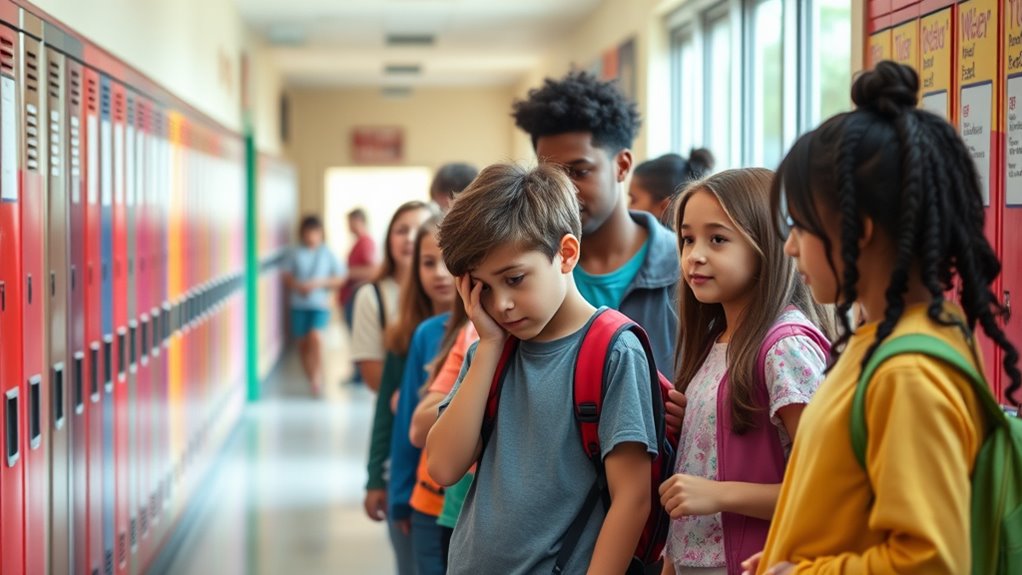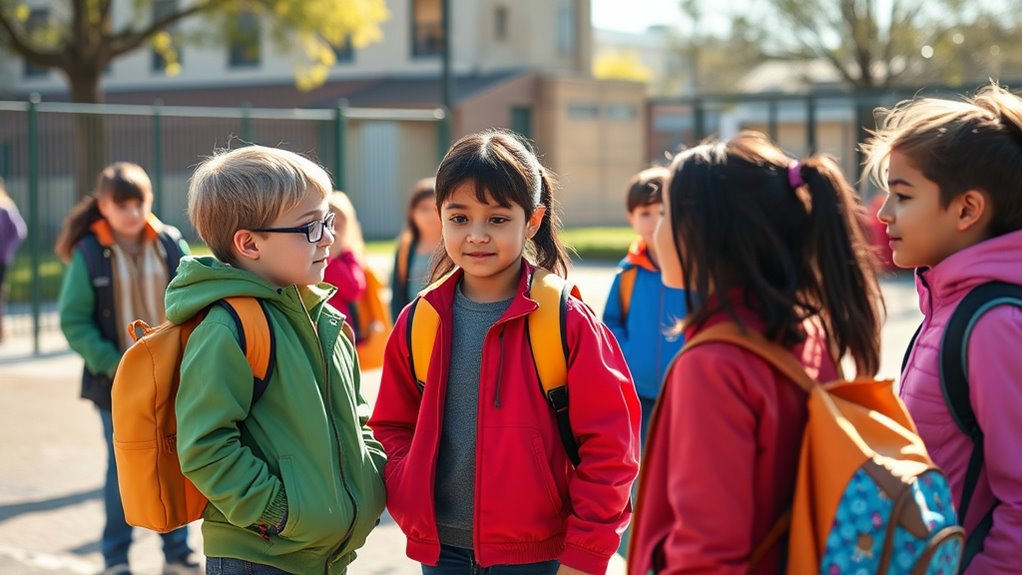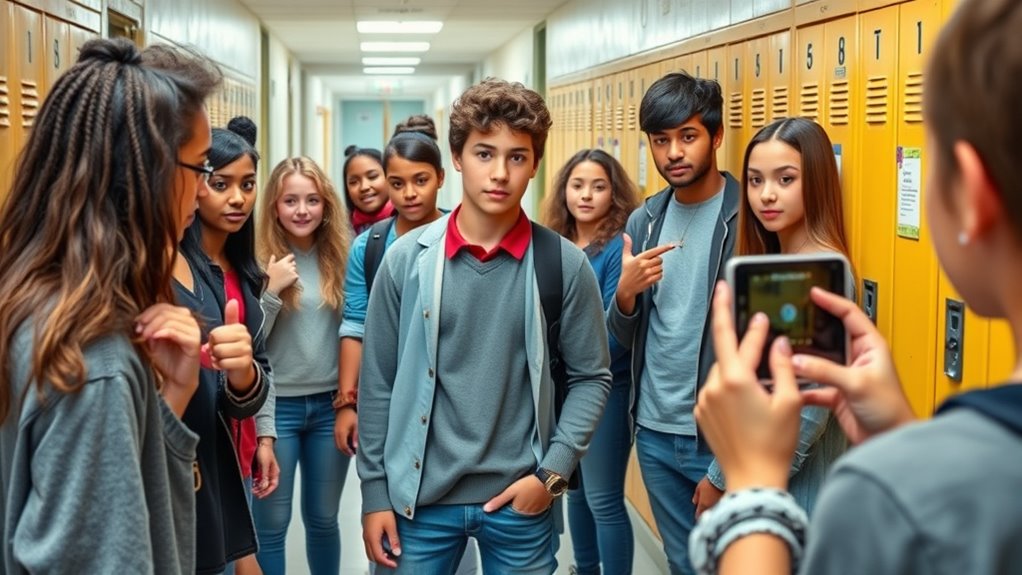To prevent bullying, recognize warning signs like hurtful comments, behavioral changes, or peer pressure. Assess the situation carefully to guarantee your safety before stepping in. Use verbal cues such as calmly asking to stop, and support victims with body language that shows you’re present. Enlist others and promote a culture of kindness, responsibility, and open communication. Reflect on your actions and learn from each experience to become a more effective bystander—more strategies await if you keep exploring.
Key Takeaways
- Recognize early warning signs of bullying, such as behavioral changes and cyberbullying indicators, to enable prompt intervention.
- Assess the situation carefully, prioritize safety, and choose appropriate verbal or non-verbal intervention strategies.
- Support victims through calm, assertive communication and body language, fostering a sense of safety and reassurance.
- Promote a supportive environment by involving peers, reporting incidents, and encouraging a culture of kindness and responsibility.
- Reflect on interventions afterward to improve response strategies, build emotional resilience, and reinforce proactive bystander behavior.
Recognizing Bullying Behavior

Recognizing bullying behavior is essential for effective intervention. You need to be alert to cyberbullying signs, such as hurtful messages, public shaming, or repeated online harassment. Keep an eye out for peers who withdraw from social activities or seem anxious about their digital interactions. Peer pressure cues can also signal bullying, like classmates encouraging others to exclude someone or participate in harmful actions. Often, victims may hesitate to speak up, so spotting these signs early helps you step in before the situation worsens. By staying attentive to subtle changes in behavior or communication, you can identify when someone is being targeted. Recognizing these warning signs is the first step toward creating a safer, more supportive environment for everyone. Incorporating AI-powered detection tools and other key visual cues into your communication can also help you advocate effectively for victims and foster a culture of kindness and respect.
Assessing the Situation Safely

Once you’ve noticed warning signs of bullying, it’s important to assess the situation carefully before stepping in. Use your situational awareness to gauge the environment and identify potential risks. Observe how others are reacting and determine if the situation might escalate or if anyone is in immediate danger. Prioritize your safety by considering safety precautions—avoid rushing in blindly or putting yourself at risk. Look for cues that show whether it’s safe to intervene directly or if you should seek help first. Remember, not every situation requires immediate action, and sometimes observing quietly is the safest choice. Staying alert and aware helps you make informed decisions that protect both yourself and others. Being familiar with safety protocols can further prepare you for various scenarios. Recognizing the importance of risk assessment can help you determine the appropriate response in each situation. Additionally, understanding the role of creative practice in developing problem-solving skills can enhance your ability to respond effectively in complex situations. Engaging in preventive strategies can also help you identify situations before they escalate into bullying events.
Intervening Verbally and Non-Verbally

Intervening verbally and non-verbally can be powerful ways to stop bullying and support someone in distress. Your words and actions can defuse tension and show empathy. Role playing exercises help you practice effective responses and build confidence, while empathy development enhances your understanding of others’ feelings. When you speak up, consider both verbal cues like calmly saying, “Please stop,” and non-verbal signals such as making eye contact or standing nearby. Use the following table to understand different strategies:
| Verbal Strategies | Non-Verbal Strategies |
|---|---|
| Calm, assertive language | Eye contact and facial expressions |
| Asking questions for clarity | Physical presence and body language |
| Offering support or reassurance | Using gestures to signal disapproval |
Additionally, incorporating expert voice actors into your approach can help convey sincerity and authority, making your intervention more effective. Utilizing digital platforms or other online resources can also enhance your ability to act confidently in various situations. Being aware of ice cream flavors and their nuances can help you connect with others when discussing common interests or diffusing tension. Understanding the hours of local stores can be helpful if you need to quickly acquire supplies to support someone in crisis.
Supporting the Victim

Supporting the victim involves offering immediate comfort and reassurance to help them feel safe and understood. Your emotional support can markedly reduce their distress and rebuild their confidence. Be mindful of confidentiality concerns; respect their privacy and avoid sharing details without permission. To effectively support:
- Listen actively, showing empathy and validating their feelings.
- Offer reassurance that they are not alone and that bullying is unacceptable.
- Ask how you can support them best, respecting their wishes and boundaries.
- Encourage them to seek additional help, such as speaking with trusted adults or support resources, to ensure ongoing safety and assistance. Recognizing the importance of emotional well-being and understanding bullying prevention strategies can help you better understand how to provide meaningful support. Additionally, being aware of mental health considerations can enhance your ability to respond compassionately and effectively.
Enlisting Help From Others

When helping a victim, enlisting the support of others can make a significant difference. Peer influence is powerful, and enlisting classmates or friends can create a united front against bullying. By involving others, you amplify the impact of your support and demonstrate that bullying isn’t tolerated. Community involvement, such as reporting to school staff or encouraging group action, strengthens your efforts. When you gather allies, you show the victim they’re not alone and that the community stands against bullying. Be confident in reaching out for help, whether it’s asking friends to intervene or informing teachers. Engaging in collective action can further promote a positive environment. Utilizing peer support can increase the effectiveness of intervention strategies. Recognizing the importance of Community involvement can enhance the overall impact of anti-bullying efforts. Creating a support network among students and staff can foster ongoing cooperation and accountability. Together, your collective action can shift the environment, making it less accepting of bullying behaviors and fostering a safer, more supportive space for everyone.
Promoting Bystander Responsibility

Promoting bystander responsibility begins with recognizing that everyone has a role in creating a safe environment. Your actions influence peer behavior and can challenge harmful cultural norms. To foster responsibility:
Everyone plays a role in fostering a safe, respectful environment through proactive peer support and challenging harmful norms.
- Understand the power of peer influence and how your response can encourage others to intervene.
- Recognize that cultural norms may implicitly condone or discourage standing up against bullying, so challenge these norms when necessary.
- Take proactive steps by speaking up, supporting victims, and setting positive examples that reinforce a culture of respect and accountability.
Reflecting on and Learning From Incidents

Reflecting on and learning from incidents is essential for improving your response to challenging situations. When you analyze what happened, you build emotional resilience and better prepare to handle future conflicts. Take time to ask yourself: What triggered the bullying? How did I respond? Could I have de-escalated the situation more effectively? This reflection helps you identify strengths and areas for growth. Use the table below to guide your learning:
| What happened? | How did I respond? | What could I improve? | Best approach next time? | Emotional resilience gained? |
|---|---|---|---|---|
| Incident details | Your reaction | Conflict de-escalation | Better response strategies | Strengthened resilience |
Regular reflection turns experience into growth, making you a stronger, more effective active bystander.
Frequently Asked Questions
How Can I Differentiate Between Teasing and Bullying?
When you try to tell the difference between teasing and bullying, look for signs to watch out for, like repeated hurtful comments or actions, and if it targets someone’s vulnerabilities. Teasing can be playful, but bullying impacts mental health negatively, causing fear or sadness. If it’s ongoing and affects someone’s well-being, it’s likely bullying. Recognizing these signs helps you step in and support effectively.
What if the Bully Is Much Bigger or Older?
Remember, size isn’t everything—”big things come in small packages.” If the bully is much bigger or older, be cautious of size disparity and escalation risk. Your safety comes first, so avoid direct confrontations. Instead, seek help from a trusted adult or use a distraction technique to de-escalate the situation. Staying safe and preventing harm is the best way you can be an active bystander.
How Do I Stay Safe When Confronting Bullying?
When confronting bullying, your safety is key. Use self-defense tactics like maintaining distance and staying calm. Seek peer support networks—friends or allies who can back you up and help de-escalate the situation. If you’re feeling threatened, don’t hesitate to remove yourself from the scene and report the incident to trusted adults. Remember, your safety comes first, and there are people ready to support you.
What Are Effective Ways to Support a Victim Emotionally?
Supporting a victim emotionally is like being a steady lighthouse in a storm. You can build empathy by listening without judgment and offering kind words. Show genuine concern through your body language and simple affirmations. Providing emotional support means being present, validating their feelings, and reminding them they’re not alone. Your empathy can be the anchor that helps them navigate their feelings and regain their strength.
How Can Schools Foster a Culture of Active Bystander Intervention?
Schools can foster a culture of active bystander intervention by promoting peer intervention and empowering students to take action. You should encourage open discussions about bullying, provide training on how to safely intervene, and recognize positive peer responses. When students feel confident and supported, they’re more likely to step in and help. This creates a safer environment where everyone understands their role in preventing bullying through bystander empowerment.
Conclusion
By actively using these strategies, you can make a real difference in preventing bullying. Remember, studies show that bystanders intervene in nearly 50% of bullying incidents when they feel empowered and prepared. Your actions can stop harm, support victims, and create a safer environment for everyone. Stay vigilant, speak up, and encourage others to do the same. Together, your collective effort can markedly reduce bullying and foster a more respectful community.









